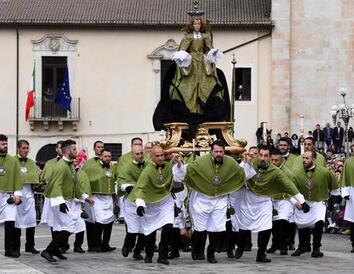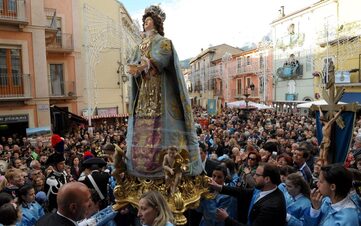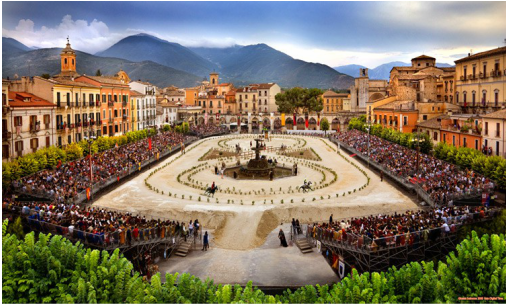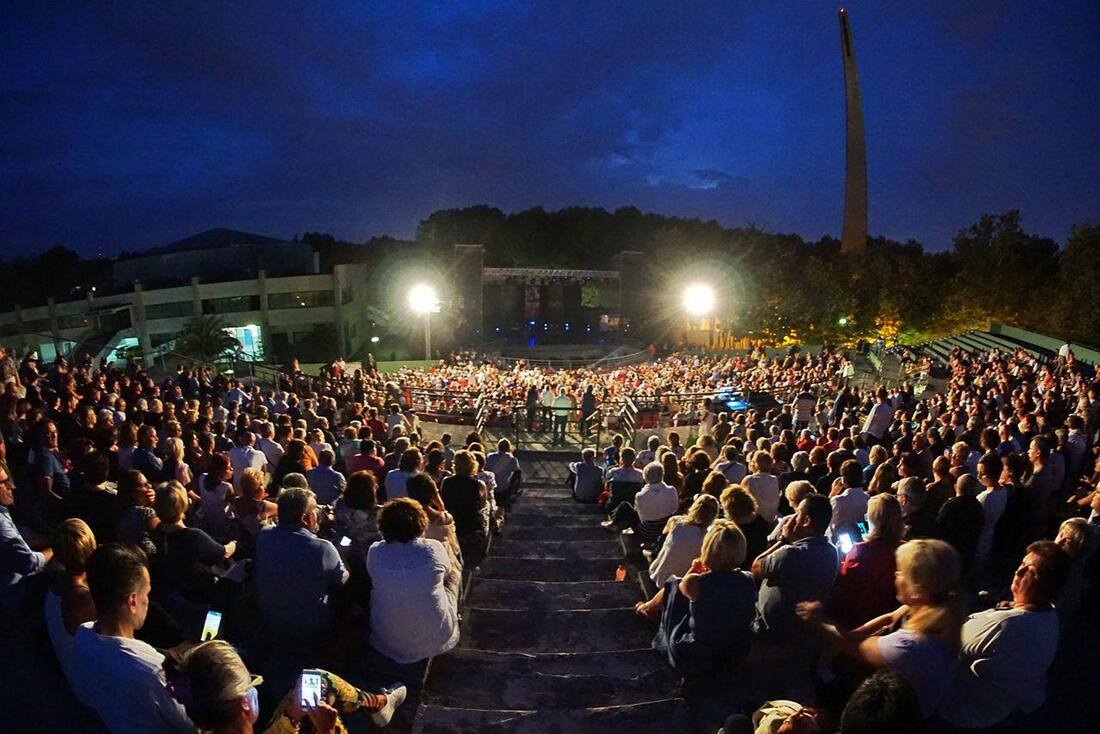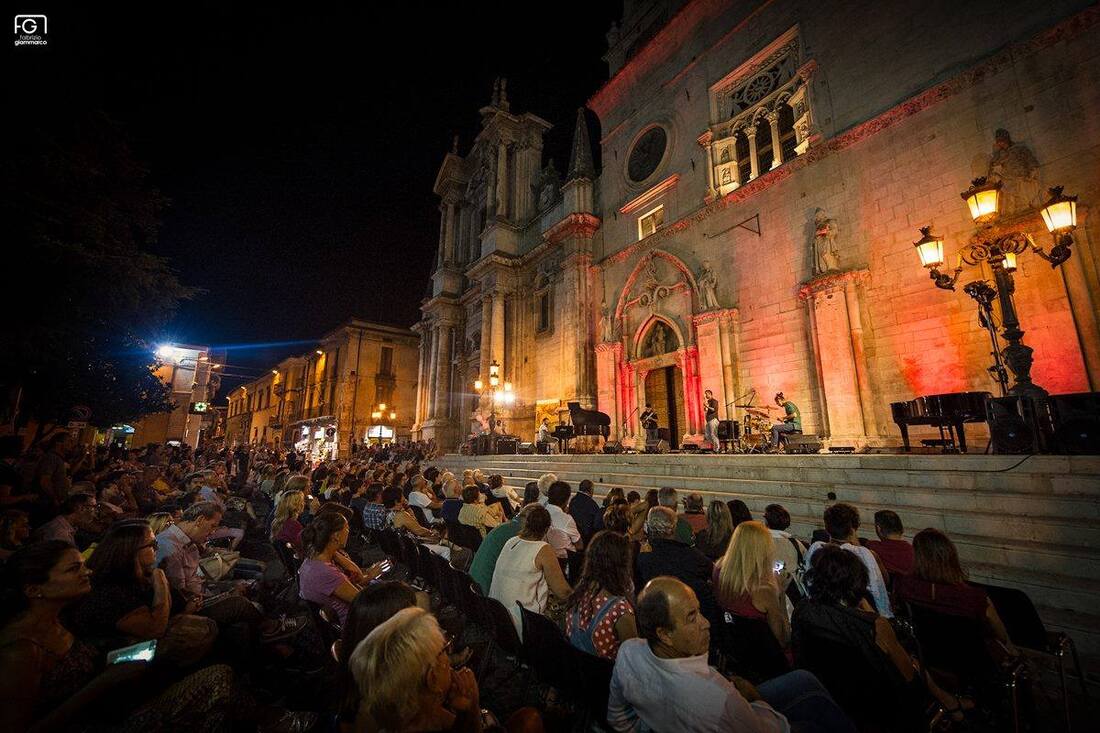Monthly Highlights |
|
|
April:Easter in Italy is an important holiday (second only to Christmas). On Easter Sunday, a lovely theatrical re-enactment of Mary running to Jesus after his resurrection: it happens every year in Sulmona, during the traditional “Runaway Madonna” (“La Madonna che scappa”), a ritual carried out every year by the town’s Confraternita di Santa Maria di Loreto. The days leading up to Easter in Italy include solemn processions and masses. Pasqua, as it's called in Italian, is a joyous celebration marked with family traditions. La Pasquetta, the Monday after Easter Sunday, is a public holiday throughout Italy so most families set out on a family hike up to the nearest mountain and then sit down for a (hopefully) sunny afternoon picnic
May: The Feast of the Madonna Della Libera. This celebration in Pratola, is a two-week-long event that starts with the novena (9 days of solemn prayers) and finishes with a celebration where the entire town takes part. The program is divided between religious events and civil events. There are many processions through the streets along with the local band and the village priest. On Friday, the pilgrims (young and old) begin a historic journey from Gioia Dei Marsi and walk for about 14 hours until they reach Pratola. On May 1st, the town of Cocullo in Abruzzo carries out a slithery ritual: the Festa dei Serpari or Serpent Festival, which sees locals parade the streets with scores of specially caught snakes. Handled by specialist handlers called serpari, the snakes are draped around the statue of San Domenico di Sora, the patron saint of Cocullo and protecter against tooth ache – and, handily enough, snake bites. Open Cantina, Cantine Aperte, an event promoted by Movimento Turismo del Vino. There are 41 wineries in the provinces of Pescara, Chieti and Teramo that will open their doors to visitors from all over Italy and abroad to promote Abruzzo wine in addition to local food products to the delight of the entire region. June:
Summer Sagras The small villages of the Abruzzo region celebrate many traditional festivals throughout the year. These festivals are called sagras. They usually center around a typical food or drink, for example, the truffle sagra, the sausage sagra, the fagioli sagra.....and many more. You can find a list of the sagras in the Abruzzo area at: http://www.saporiesagre.it/ July:
Jousting Tournament On the last weekend of July – this year on July 25 and July 26, 2020 – the town of Sulmona hosts an historical Renaissance reenactment: Giostra Cavalleresca, the knight jousting tournament. The knights of Sulmona’s ‘Sestieri’ and ‘Borghi’ (neighborhood teams) take part in a two-day competition to win the ‘palio’ (prize), a canvas painting made every year by a different artist. A famous female celebrity (queen) watches over the festivities. An amazing medieval parade starts off the festival with over 500 participants all dressed in historical costumes. Pescara Jazz Mountain Jazz August:
Piano, Piano in Sulmona Strano Film Festival in Capestrano September:
Borgo di Fate A magical night where you can dive between fairies , witches and elves who will accompany you to the discovery of one of the most beautiful the villages of Abruzzo: Roccacasale. October: Vendemmia - The Italian word for Grape Harvest Ah Vino! September and October are the months of the grape harvest and of the many celebrations dedicated to it. Abruzzo has a long history of wine making. It is the seventh most productive region in Italy. Taste the regions most popular wines such as the Montepulciano, Trebbiano and Pecorino wines as well as the Cerasuolo and Passerina varieties at a special wine-tasting at the nearby Margiotta Wine Open Cantina: Another Cantina Aperto happens around harvest time in Abruzzo. Spend the day picking grapes and celebrating the harvest with one of the many cantine open for visitors. November: The Olive Harvest Come along and experience the local olive harvest where local farmers will show us the different techniques for gathering the olives, how to identify them and their diverse characteristics. After some time picking olives, we will head to the olive oil mill and learn all about Extra Virgin olive oil extraction. Enjoy an olive oil tasting of the regions award-winning olive oils, local cheeses and Wine. You will learn how to recognize good quality olive oil and learn about its uses and qualities of what makes a great extra virgin olive oil. December:
Christmas Markets There are Christmas Markets in many of the villages in Abruzzo. Specifically in our Peligna Valley, the villages of Roccacasale, Sulmona and Pacentro host amazing markets with crafts, gift ideas, food, music, shows, nativity scenes and of course, the arrival of Babbo Natale. Living Nativity (Presepe Vivente) Peruse this list of living nativities in the region of Abruzzo. https://www.presepevivente.it/Italia/Abruzzo The TranSiberiana D'Italia Train to Christmas Markets. The trip takes about 8 hours starting in Sulmona with stops along the way in beautiful little mountain villages with folk musicians playing for the entire trip. Each village will showcase their wares for the Christmas season along with culinary delights of the area. |
The Abruzzo Region |
Much of the Abruzzo region is in national or regional parks. Parco Nazionale d'Abruzzo is a large protected area with picturesque hiking and biking trails. Its seven visitor centers have trail maps and information. Guided tours can be arranged in Pescasseroli. Gran Sasso, the highest point in the Apennine Mountains, has hiking trails, spring wildflowers, and winter skiing. The region is dotted with castles, mainly built in the middle ages. While some are just ruins, there are also preserved castles and watchtowers.
Pescasseroli is situated in a wide plain surrounded by a mountainous landscape in the heart of the Abruzzo National Park. Because of its location, Pescasseroli is a tourist resort in summer for hiking and in winter for skiing and ice skating. The area has been inhabited since prehistoric times and was a center of woodworking and sheep raising for centuries. Pescasseroli has ruins of a 13th century castle, churches, and a natural history museum. L'Aquila, the capital of the Abruzzo region, is a medieval town dating from 1240 in a pretty setting. L'Aquila has a walled historic center with narrow streets and pretty squares. The church of San Bernardino di Siena is a beautiful Renaissance church. Santa Maria di Collemaggio has a pink and white facade, 14th century mosaics, and a Gothic interior. L'Aquila's well-preserved 16th century castle houses the National Museum of the Abruzzo. Sulmona is situated at the confluence of two rivers below the mountains. Sulmona conserves much of its medieval past such as its Cathedral, several churches, its architecture, and a medieval gate and aquaduct. There are also a number of Renaissance buildings, an interesting museum of antiquity, and cultural events. Sulmona has a large, round piazza where locals and tourists enjoy drinks outdoors. Sulmona is famous for its confetti candy, sugared almonds made into floral shapes, and you'll see it in Sulmona's shops. Wool goods from Sulmona are also famous. Famous events in Sumona include the Easter Procession in Spring and the Jousting Tournament in s ummer. Pescara, on the Adriatic coast, is the largest city in the Abruzzo region. Although it was badly bombed during the war, it's now an example of a modern Italian city and still retains some historic elements. Pescara has a seaside promenade, 20 km of sandy beach, great seafood restaurants, and lots of nightlife. The Museum of the Abruzzi People has a huge collection of artifacts about life in the Abruzzo from prehistoric times through the 19th century. Pescara has a few other museums and several churches and buildings, too. In July, Pescara holds an international jazz festival. Pescara is also known for its shopping Corso (street lined with shops) filled with all Italian products. More interesting villages in the Abruzzo Area:
|
